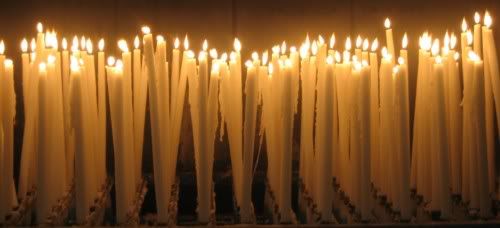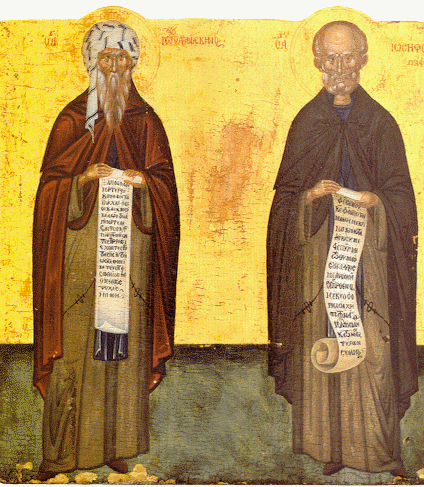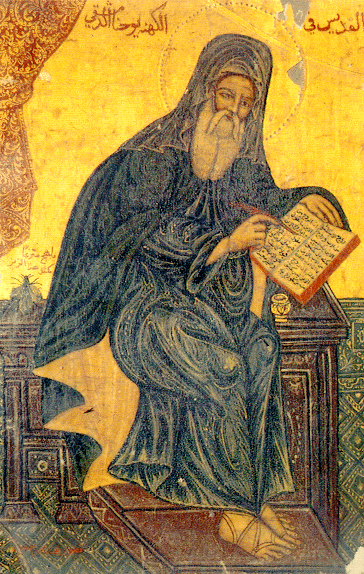Today, December 4, we celebrate the feast day of Saint John Damascene (John of Damascus, 676-749), hymn-writer, defender of icons, and Doctor of the Church. Saint John is considered the last of the four fathers of the Eastern Church. He devoted himself to religious poetry, theological arguments in defense of Church doctrine, and refutation of heresies. A prolific writer, many of his works remain, including beautiful canons on the Assumption of Our Blessed Mother, Easter, and the Ascension. His eloquent defense of icons and Christian art earned him the title, “The Doctor of Christian Art.”
In defense of icons and holy art, Saint John wrote “On Holy Images.” An excerpt of that work follows:
“Now, as we are talking of images and worship, let us analyse the exact meaning of each. An image is a likeness of the original with a certain difference, for it is not an exact reproduction of the original. Thus, the Son is the living, substantial, unchangeable Image of the invisible God, bearing in Himself the whole Father, being in all things equal to Him, differing only in being begotten by the Father, who is the Begetter; the Son is begotten. The Father does not proceed from the Son, but the Son from the Father. It is through the Son, though not after Him, that He is what He is, the Father who generates. In God, too, there are representations and images of His future acts,-that is to say, His counsel from all eternity, which is ever unchangeable. That which is divine is immutable; there is no change in Him, nor shadow of change. Blessed Denis, [note: the Pseudo-Dionysius] who has made divine things in God's presence his study, says that these representations and images arc marked out beforehand. In His counsels, God has noted and settled all that He would do, the unchanging future events before tbey came to pass. In the same way, a man who wished to build a house would first make and think out a plan. Again, visible things are images of invisible and intangible things, on which they throw a faint light. Holy Scripture clothes in figure God and the angels, and the same holy man (Blessed Denis) explains why. When sensible things sufficiently render what is beyond sense, and give a form to what is intangible, a medium would be reckoned imperfect according to our standard, if it did not fully represent material vision, or if it required effort of mind. If, therefore, Holy Scripture, providing for our need, ever putting before us what is intangible, clothes it in flesh, does it not make an image of what is thus invested with our nature, and brought to the level of our desires, yet invisible? A certain conception through the senses thus takes place in the brain, which was not there before, and is transmitted to the judicial faculty, and added to the mental store. Gregory, who is so eloquent about God, says that the mind, which is set upon getting beyond corporeal things, , is incapable of doing it. For the invisible things of God since the creation of the world are made visible through images. We see images in creation which remind us faintly of God, as when, for instance, we speak of the holy and adorable Trinity, imaged by the sun, or light, or burning rays, or by a running fountain, or a full river, or by the mind, speech, or the spirit within us, or by a rose tree, or a sprouting flower, or a sweet fragrance.
Again, an image is expressive of something in the future, mystically shadowing forth what is to happen. For instance, the ark represents the image of Our Lady, Mother of God, so does the staff and the earthen jar. The serpent brings before us Him who vanquished on the Cross the bite of the original serpent; the sea, -water, and the cloud the grace of baptism.
Again, things which have taken place are expressed by images for the remembrance either of a wonder, or an honour, or dishonour, or good or evil, to help those who look upon it in after times that we may avoid evils and imitate goodness. It is of two kinds, the written image in books, as when God had the law inscribed on tablets, and when He enjoined that the lives of holy men should be recorded and sensible memorials be preserved in remembrance; as, for instance, the earthen jar and the staff in the ark. So now we preserve in writing the images and the good deeds of the past. Either, therefore, take away images altogether and be out of harmony with God ,who made these regulations, or receive them with the language and in the manner which befits them. In speaking of the manner let us go into the question of worship.
Worship is the symbol of veneration and of honour. Let us understand that there are different degrees of worship. First of all the worship of latreia, which we show to God, who alone by nature is worthy of worship. When, for the sake of God who is worshipful by nature, we honour His saints and servants, as Josue and Daniel worshipped an angel, and David His holy places, when be savs, "Let us go to the place where His feet have stood." Again, in His tabernacles, as when all the people of Israel adored in the tent, and standing round the temple in Jerusalem, fixing their gaze upon it from all sides, and worshipping from that day to this, or in the rulers established by Him, as Jacob rendered homage to Esau, his elder brother, and to Pharaoh, the divinely established ruler. Joseph was worshipped bv his brothers. I am aware that worship was based on honour, as in the case of Abraham and the sons of Emmor. Either, then, do awav with worship, or receive it altogether according to its proper measure.
Answer me this question. Is there only one God? You answer, "Yes, there is only one Law-giver." Why, then, does He command contrary things? The cherubim are not outside of creation; why, then, does He allow cherubim carved by the hand of man to overshadow the mercy-scat? Is it not evident that as it is impossible to make an image of God, who is uncircumscribed and impassible, or of one like to God, creation should not be worshipped as God. He allows the image of the cherubim who are circumscribed, and prostrate in adoration before the divine throne, to be made, and thus prostrate to overshadow the mercy-seat. It was fitting that the image of the heavenly choirs should overshadow the divine mysteries. Would you say that the ark and staff and mercy-scat were not made? Are they not produced by the hand of man? Are they not due to what you call contemptible matter? What was the tabernacle itself? Was it not an image? Was it not a type and a figure? Hence the holy Apostle's words concerning the observances of the law, "Who serve unto the example and shadow, of heavenly things." As it was answered to Moses, when he was to finish the tabernacle: "See" (He says), "that thou make all things according to the pattern which was shown thee on the Mount." But the law ,-,,as not an image. It shrouded the image. In the words of the same Apostle, the law, contains the shadow of the goods to come, not the image of those things. For if the law should forbid images, and vet be itself a forerunner of images, what should we say? If the tabernacle 'was a figure, and the type of a type, why does the law not prohibit image-making? But this is not in the least the case. There is a time for everything.
Of old, God the incorporeal and uncircumscribed was never depicted. Now, however, when God is seen clothed in flesh, and conversing with men, I make an image of the God whom I see. I do not worship matter, I worship the God of matter, who became matter for my sake, and deigned to inhabit matter, who worked out my salvation through matter. I will not cease from honouring that matter which works my salvation. I venerate it, though not as God. How could God be born out of lifeless things? And if God's body is God by union, it is immutable. The nature of God remains the same as before, the flesh created in time is quickened by, a logical and reasoning soul.
I honour all matter besides, and venerate it. Through it, filled, as it were, me. Was not the with a divine power and grace, my salvation has come to thrice happy and thrice blessed wood of the Cross matter? Was not the sacred and holy mountain of Calvary matter? What of the life-giving rock, the Holy Sepulchre, the source of our resurrection: was it not matter? Is not the most holy book of the Gospels matter? Is not the blessed table matter which gives us the Bread of Life' Are not the gold and silver matter, out of which crosses and altar-plate and chalices are made? And before all these things, is not the body and blood of our Lord matter? Either do away with the veneration and worship due to all these things, or submit to the tradition of the Church in the worship of images, honouring God and His friends, and following in this the grace of the Holv Spirit.”
Why pray the Rosary every day for a year?
Each time the Blessed Virgin has appeared-- whether it be to Saint Bernadette Soubirous at Lourdes; to Lucia, Jacinta, and Francisco at Fatima; or to Mariette Beco at Banneux-- she has asserted the importance, saving grace, and power of praying the Holy Rosary on a daily basis. Based upon her words, the Rosary is penance and conversion for sinners, a pathway to peace, an end to war, and a powerful act of faith in Jesus Christ. Pope Paul VI presented the Rosary as a powerful means to reach Christ "not merely with Mary but indeed, insofar as this is possible to us, in the same way as Mary, who is certainly the one who thought about Him more than anyone else has ever done."
To show us how this is done, perhaps no one has been more eloquent than the great Cardinal Newman, who wrote: "The great power of the Rosary consists in the fact that it translates the Creed into Prayer. Of course, the Creed is already in a certain sense a prayer and a great act of homage towards God, but the Rosary brings us to meditate again on the great truth of His life and death, and brings this truth close to our hearts. Even Christians, although they know God, usually fear rather than love Him. The strength of the Rosary lies in the particular manner in which it considers these mysteries, since all our thinking about Christ is intertwined with the thought of His Mother, in the relations between Mother and Son; the Holy Family is presented to us, the home in which God lived His infinite love."
As Mary said at Fatima, "Jesus wants to use you to make Me known and loved. He wishes to establish the devotion to My Immaculate Heart throughout the world. I promise salvation to whoever embraces it; these souls will be dear to God, like flowers put by Me to adorn his throne."

Subscribe to:
Post Comments (Atom)











0 comments:
Post a Comment
Thanks for leaving a comment. If you wish to submit a prayer request, however, please do so above, using the "Contact" tab.